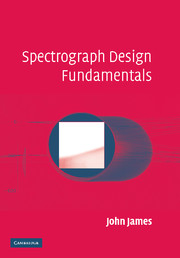Book contents
- Frontmatter
- Contents
- Preface
- Acknowledgements
- 1 A brief history of spectroscopy
- 2 The relevant regions of the electromagnetic spectrum
- 3 Geometrical optics
- 4 Optical aberrations
- 5 Fourier transforms: a brief revision
- 6 Physical optics and diffraction
- 7 The prism spectrograph
- 8 The plane grating spectrograph
- 9 The concave grating spectrograph
- 10 The interference spectrograph
- 11 The multiplex spectrometer
- 12 Detectors
- 13 Auxiliary optics
- 14 Optical design
- 15 Mechanical design and construction
- 16 Calibration
- 17 The alignment of a spectrograph
- Appendix 1 Optical aberrations
- Appendix 2 Wavelengths of spectral lines for calibration
- Appendix 3 The evolution of a Fabry–Perot interference spectrograph
- Appendix 4 The common calibration curve in silver halide spectrophotometry
- Bibliography
- Index
9 - The concave grating spectrograph
Published online by Cambridge University Press: 02 September 2009
- Frontmatter
- Contents
- Preface
- Acknowledgements
- 1 A brief history of spectroscopy
- 2 The relevant regions of the electromagnetic spectrum
- 3 Geometrical optics
- 4 Optical aberrations
- 5 Fourier transforms: a brief revision
- 6 Physical optics and diffraction
- 7 The prism spectrograph
- 8 The plane grating spectrograph
- 9 The concave grating spectrograph
- 10 The interference spectrograph
- 11 The multiplex spectrometer
- 12 Detectors
- 13 Auxiliary optics
- 14 Optical design
- 15 Mechanical design and construction
- 16 Calibration
- 17 The alignment of a spectrograph
- Appendix 1 Optical aberrations
- Appendix 2 Wavelengths of spectral lines for calibration
- Appendix 3 The evolution of a Fabry–Perot interference spectrograph
- Appendix 4 The common calibration curve in silver halide spectrophotometry
- Bibliography
- Index
Summary
The Rowland grating
This is a grating ruled on a concave spherical mirror, in consequence of which it has a self-focusing property and needs no other optical component to produce a spectrum from a point or short line source. It is the invention of H. A. Rowland of Johns Hopkins University who gave an account of it in 1883. The rulings are the intersections of the sphere with a set of parallel, equi-spaced planes, so that the interval between rulings is not constant on the surface of the sphere, and the device, although it is a spherical mirror, has a definite optic axis.
The focusing property is as follows:
The grating is ruled on a spherical mirror of radius R. There is a circle, the Rowland circle, touching the sphere at its vertex perpendicular to the rulings and of radius R/2. The elementary theory of the grating states that monochromatic light from any point on this circle is diffracted according to the grating equation, and is subsequently focused at another point on the Rowland circle.
The theorem is not exact. There is no point focus but an approximation to the proof can be given by elementary geometry. In Fig. 9.1 the grating is displaced by an infinitesimal amount along the optic axis and intersects the Rowland circle at points x, x′. Suppose the grating constant at x is a.
Information
- Type
- Chapter
- Information
- Spectrograph Design Fundamentals , pp. 89 - 100Publisher: Cambridge University PressPrint publication year: 2007
